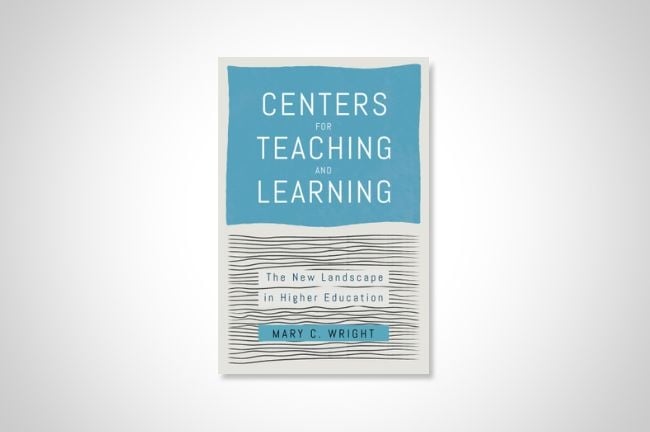You have /5 articles left.
Sign up for a free account or log in.

Johns Hopkins University Press
Centers for Teaching and Learning: The New Landscape in Higher Education by Mary C. Wright
Published in September 2023
The educational developer community is tightly knit. An unusually high percentage of educators who read Centers for Teaching and Learning: The New Landscape in Higher Education will personally know the book’s author, Mary Wright.
We know Mary as a leader in the field of educational development, a past president of POD Network and a valued colleague, mentor and friend.
At Brown University, Mary serves as the associate provost for teaching and learning, executive director of the Sheridan Center for Teaching and Learning, and a research professor of sociology.
The book has a guaranteed readership in the U.S. of at least 1,209. That is the number of CTLs that Mary identifies in her sample. As Mary’s research identifies only 228 of these CTLs as “centers of one” (pg. 157), the total number of guaranteed readers for this book should run in the many thousands.
This book, however, deserves a much wider readership than those of us working in CTLs. Indeed, a key theme of the book is the growing role that CTLs play across institutions as catalysts, enablers and levers of organizational change.
Centers for Teaching and Learning can be read in two (complementary) ways. On one level, the book provides a careful scholarly investigation of the structure, goals and impact of CTLs and the educators who comprise these units. From this perspective, the book takes the CTL as the unit of analysis, and the reader gains deep insight into how CTLs have developed, the work that they do and how the roles of these units have evolved.
The second way to read Centers for Teaching and Learning is by framing the unit of analysis as the university. From this perspective, every academic leader and postsecondary educator should invest time in reading (and discussing) this book.
As the book convincingly demonstrates, “CTLs are now playing a broader role on their campuses to support operational needs, strategic aims and organizational change” (pg. 200). The evolution of the campus roles of CTLs from the margins to the center of institutional strategy and focus has been gaining momentum over the past couple of decades.
This shift has been reflected in the expanded capacities and missions of CTLs, as they have taken on greater responsibilities (digital learning, instructional design, writing instruction, etc.) beyond their educational development roots.
The pandemic accelerated the shift of CTLs into the core of university operation, as the expertise, training, consultation and services offered by CTLs have been recognized as essential for academic continuity.
While celebrating the role that CTLs are increasingly playing to advance learning and partner with faculty members to improve teaching, the book identifies several potential challenges for these units. In comparing the change in staffing (and staffing ratios) to the expanding list of campuswide CTL responsibilities and provided services, Wright notes that there is a risk that CTL staffers are being spread too thin.
Further, despite sustained and creative efforts by campus and national leaders in the field, there persists a gap in understanding the institutional impacts and day-to-day work of CTLs among too many academic leaders and faculty members.
While many presidents, provosts, deans and professors have internalized the essential role that CTLs play in advancing learning and ensuring educational resilience, this knowledge does not always translate into institutional status or adequate funding support.
CTLs live in that productive but challenging borderland between a campus service organization and a disciplinary-based academic department. As mission-based units dedicated to advancing learning and teaching success for all students and educators, CTLs are, by necessity, proactive, entrepreneurial and scrappy.
Centers for Teaching and Learning will inspire anyone considering a nontraditional academic career.
By reading this book, every professor motivated to improve their teaching will gain valuable knowledge of how to work with their campus CTL.
Every president, provost or dean interested in developing and nurturing institutional structures that advance learning and bolster educators should place Centers for Teaching and Learning at the top of their must-read list.
What are you reading?








